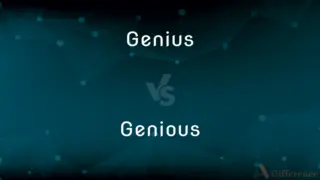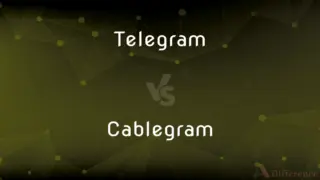Sonata vs. Concerto — What's the Difference?
By Tayyaba Rehman — Updated on October 23, 2023
A Sonata is a musical composition typically for a solo instrument, while a Concerto is for a solo instrument with orchestral accompaniment.

Difference Between Sonata and Concerto
Table of Contents
ADVERTISEMENT
Key Differences
Listening to a Sonata, one might appreciate the depth and expression a single instrument can offer. Meanwhile, in a Concerto, listeners are treated to a dynamic conversation between a soloist and an orchestra, each amplifying the other's musical statements.
Tayyaba Rehman
Oct 23, 2023
A Sonata and a Concerto are both classical music compositions, but they serve different purposes and structures. A Sonata is generally written for a solo instrument, highlighting its capabilities and musical narratives. In contrast, a Concerto is crafted to showcase the dialog between a solo instrument and an orchestra.
Tayyaba Rehman
Oct 23, 2023
In terms of form, a Sonata often adheres to a three or four-movement structure, with each movement offering contrasting moods and tempos. A Concerto, on the other hand, also has multiple movements (typically three), but these movements present an exchange between the individual instrument and the ensemble.
Tayyaba Rehman
Oct 23, 2023
The origin of the Sonata can be traced back to the Baroque period, evolving over time to suit various instruments. The Concerto emerged around the same era, but its development was aimed at demonstrating the virtuosity of a solo performer juxtaposed against a larger musical group.
Tayyaba Rehman
Oct 23, 2023
The term Sonata is sometimes used to denote compositions involving multiple instruments, such as a "piano sonata" or a "violin sonata". Conversely, a Concerto is unmistakably identified by the soloist's interaction with the orchestra, as in a "piano concerto" or "violin concerto".
Tayyaba Rehman
Oct 23, 2023
ADVERTISEMENT
Comparison Chart
Structural Movements
Typically three or four movements.
Typically three movements.
Tayyaba Rehman
Oct 23, 2023
Historical Origin
Emerged in the Baroque period.
Emerged around the Baroque period.
Tayyaba Rehman
Oct 23, 2023
Showcase
Highlights capabilities of a single instrument.
Demonstrates a dialog between a solo instrument and orchestra.
Tayyaba Rehman
Oct 23, 2023
ADVERTISEMENT
Definitions
Sonata
A work typically in several movements.
The Sonata transitioned from a fast to a slow movement beautifully.
Tayyaba Rehman
Oct 23, 2023
Concerto
A composition that showcases the soloist's virtuosity.
The violin Concerto allowed the performer to display her exceptional skills.
Tayyaba Rehman
Oct 23, 2023
Sonata
A composition rooted in the classical tradition.
The Sonata had a clear influence from the Romantic era.
Tayyaba Rehman
Oct 23, 2023
Concerto
A work typically in three movements.
The Concerto's final movement was both lively and triumphant.
Tayyaba Rehman
Oct 23, 2023
Sonata
A piece emphasizing the expressive capabilities of an instrument.
The violin Sonata showcased the instrument's vast range and emotion.
Tayyaba Rehman
Oct 23, 2023
Concerto
A musical composition for a solo instrument accompanied by an orchestra.
Mozart's Piano Concerto No. 21 is a renowned piece in classical music.
Tayyaba Rehman
Oct 23, 2023
Sonata
A musical composition for a solo instrument.
Beethoven's Moonlight Sonata is a classic piece for solo piano.
Tayyaba Rehman
Oct 23, 2023
Concerto
A dialogue between a solo instrument and orchestral ensemble.
The Concerto presented a harmonious conversation between the cello and the orchestra.
Tayyaba Rehman
Oct 23, 2023
Sonata
An extended composition, often for piano.
The pianist played a contemporary Sonata that was both complex and mesmerizing.
Tayyaba Rehman
Oct 23, 2023
Concerto
A piece emphasizing contrast between individual and group.
The Concerto highlighted the pianist's melodies against the rich tapestry of the orchestra.
Tayyaba Rehman
Oct 23, 2023
Sonata
Sonata (; Italian: [soˈnaːta], pl. sonate; from Latin and Italian: sonare [archaic Italian; replaced in the modern language by suonare], "to sound"), in music, literally means a piece played as opposed to a cantata (Latin and Italian cantare, "to sing"), a piece sung.
Tayyaba Rehman
May 03, 2018
Concerto
A concerto (; plural concertos, or concerti from the Italian plural) is, from the late Baroque era, mostly understood as an instrumental composition, written for one or more soloists accompanied by an orchestra or other ensemble. The typical three-movement structure, a slow movement (e.g., lento or adagio) preceded and followed by fast movements (e.g.
Tayyaba Rehman
May 03, 2018
Sonata
A composition for one or more solo instruments, one of which is usually a keyboard instrument, usually consisting of three or four independent movements varying in key, mood, and tempo.
Tayyaba Rehman
May 03, 2018
Concerto
A composition for an orchestra and one or more solo instruments, typically in three movements.
Tayyaba Rehman
May 03, 2018
Sonata
(music) A musical composition for one or a few instruments, one of which is frequently a piano, in three or four movements that vary in key and tempo.
Tayyaba Rehman
May 03, 2018
Concerto
(music) A piece of music for one or more solo instruments and orchestra.
Tayyaba Rehman
May 03, 2018
Sonata
An extended composition for one or two instruments, consisting usually of three or four movements; as, Beethoven's sonatas for the piano, for the violin and piano, etc.
Tayyaba Rehman
May 03, 2018
Concerto
A composition (usually in symphonic form with three movements) in which one instrument (or two or three) stands out in bold relief against the orchestra, or accompaniment, so as to display its qualities or the performer's skill.
Tayyaba Rehman
May 03, 2018
FAQs
Can a Sonata be for more than one instrument?
Yes, while traditionally for a solo instrument, a Sonata can also be for two instruments, like a "violin and piano sonata".
Tayyaba Rehman
Oct 23, 2023
Which composition primarily focuses on a solo instrument?
Sonata focuses primarily on a solo instrument.
Tayyaba Rehman
Oct 23, 2023
Can a Concerto be for multiple solo instruments?
Yes, there are double, triple, or even quadruple concertos featuring multiple solo instruments.
Tayyaba Rehman
Oct 23, 2023
Which composition type emerged in the Baroque period?
Both Sonata and Concerto emerged around the Baroque period.
Tayyaba Rehman
Oct 23, 2023
Does a Concerto always have an accompanying orchestra?
Yes, a Concerto is characterized by a solo instrument accompanied by an orchestra.
Tayyaba Rehman
Oct 23, 2023
Which composition is often used to display a musician's virtuosity?
A Concerto is often used to showcase the virtuosity of a solo performer.
Tayyaba Rehman
Oct 23, 2023
How many movements are typically in a Concerto?
A Concerto typically has three movements.
Tayyaba Rehman
Oct 23, 2023
How many movements does a Sonata usually have?
A Sonata typically has three or four movements.
Tayyaba Rehman
Oct 23, 2023
Is an orchestra always present in a Concerto?
Yes, a defining feature of a Concerto is the presence of an orchestra accompanying a solo instrument.
Tayyaba Rehman
Oct 23, 2023
In which composition is the interaction between solo instrument and orchestra prominent?
In a Concerto, the interaction between the solo instrument and orchestra is prominent.
Tayyaba Rehman
Oct 23, 2023
Can both Sonata and Concerto be dramatic and expressive?
Yes, both Sonata and Concerto can be highly dramatic and expressive, depending on the composition and performance.
Tayyaba Rehman
Oct 23, 2023
Which is generally longer, a Sonata or a Concerto?
While it can vary, Concertos are generally longer than Sonatas.
Tayyaba Rehman
Oct 23, 2023
Is "Moonlight Sonata" a Concerto?
No, "Moonlight Sonata" is a Sonata by Beethoven for solo piano.
Tayyaba Rehman
Oct 23, 2023
Can a Sonata be composed in the modern era?
Yes, while the Sonata form has classical roots, composers in the modern era still write Sonatas.
Tayyaba Rehman
Oct 23, 2023
Which composition emphasizes the dialog between a solo instrument and an ensemble?
A Concerto emphasizes the dialog between a solo instrument and an ensemble.
Tayyaba Rehman
Oct 23, 2023
Author Spotlight
Written by
Tayyaba RehmanTayyaba Rehman is a distinguished writer, currently serving as a primary contributor to askdifference.com. As a researcher in semantics and etymology, Tayyaba's passion for the complexity of languages and their distinctions has found a perfect home on the platform. Tayyaba delves into the intricacies of language, distinguishing between commonly confused words and phrases, thereby providing clarity for readers worldwide.

















































